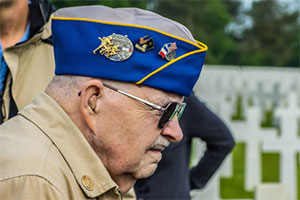D-Day 70 Years Later

The letter’s dateline read: “Yale University, New Haven, Conn., April 30, 1942.”
The author was a 20-year-old Yale student, who, out of humility, prefers to remain unnamed. At 5’2”, he was shorter than the minimum height requirement for the U.S. Army Air Corps, but, undaunted, the freshman persisted in his attempts to enlist during WWII. He had finally succeeded, and, in four pages of neat script, was writing to tell his father this news: he was leaving his university to join the fight.
In words that brooked no argument, the young man wrote:
“I have made my decision, and I told them that I wished to report in July for immediate service. I know how much you and Mother have wanted me to get a college education, but after thinking it over, I have decided that I can’t remain at Yale.”
He laid out his reasons: the war was at full pitch, the Air Corps needed men badly, he had passed all the tests, he had no wife or children depending upon him. “There is a war going on; there is a job to be done, today....We must all do our part in this great effort, and my part, as I see it, is to serve in the Air Corps now.
He begged for his parents’ blessing, writing that without it, he would be “lost.” But, the young man concluded, “I am buoyed up and ready to give everything I have to my country in this capacity.”
Seventy years ago tomorrow, on June 6, 1944, the largest invasion fleet ever assembled, before or since, landed 156,000 allied troops on five beachheads in Normandy, France. That day, “D-Day,” turned the tide of the war.
D-Day involved not only infantry divisions whose harrowing landings on beaches given names like Utah and Omaha were depicted in the Steven Spielberg film Saving Private Ryan. While U.S. Navy PT boats carrying the infantry crossed the English Channel, squadrons of B-17 bombers flew into France and dropped bombs on Nazi gun placements, pounding the beaches in the minutes before Allied troops would land.
The Yale freshman flew on one of those B-17s on D-Day. His small stature made him perfect for his job on that plane: navigator. Navigators, whose duty it was to determine the plane’s position relative to earth, were tucked in the belly of the nose of the plane. The young man, who became a captain in the Air Corps, flew in one of the so-called “Flying Fortresses” on D-Day and on 34 other missions over France and Germany during WWII.
In a sermon preached at the Fourth Presbyterian Church of Chicago on the Fourth of July, 2010, Reverend John Buchanan told the story of this determined young man and observed, “His thoughtful, modest letter is our nation at its best. His uncomplicated responsibility for the common good, his simple, but profound willingness to put his life on the line is our nation at its best—and what binds us together.”
He returned from war, but he never returned to Yale. Life intervened: he entered the family business upon his father’s retirement and married the woman he loved.
They have been wed for 69 years. He lives still. He is 92 years old.
Sightings looks at the world around us and makes observations about it. Look tomorrow, June 6, and see this: the last of what journalist Tom Brokaw called the Greatest Generation, men and women who, seventy years ago, left the lives they knew and laid them down for the world.